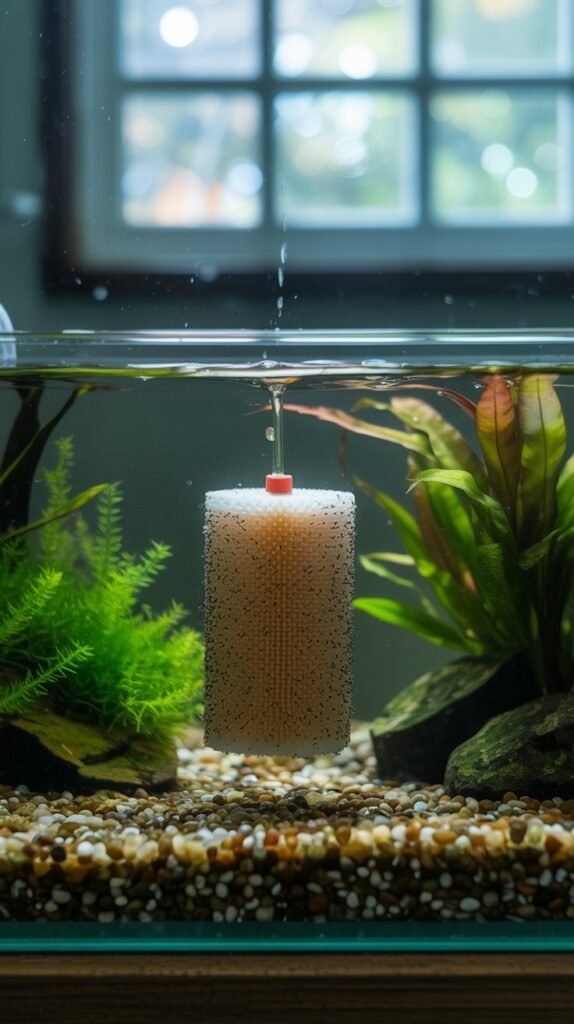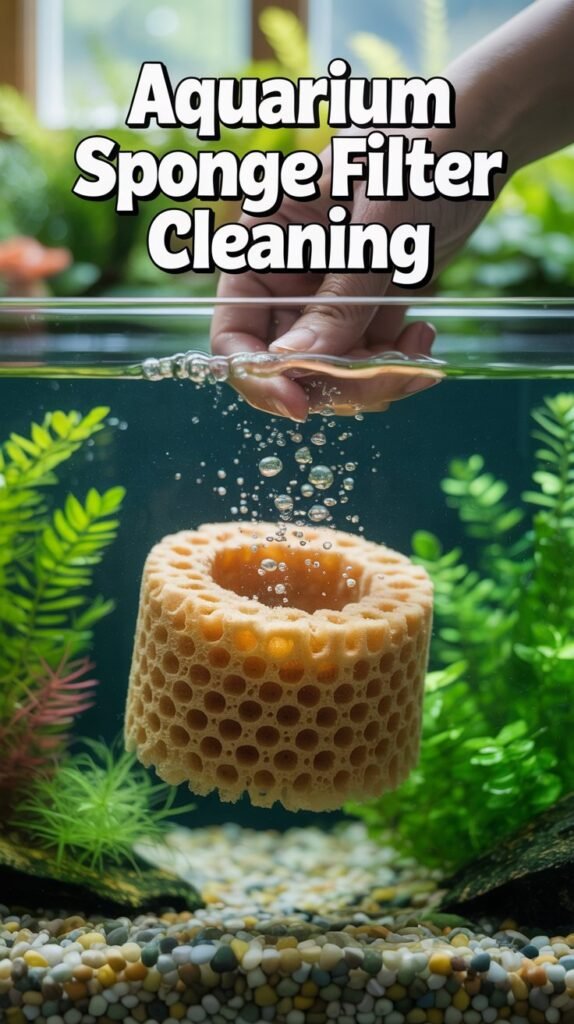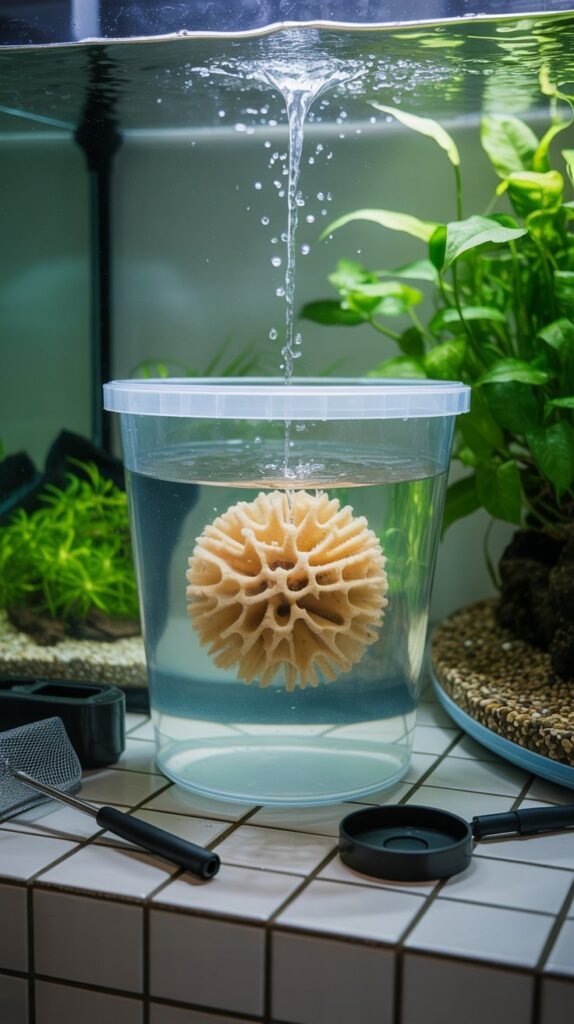Aquarium sponge filters are among the most popular and effective filtration systems used in fish tanks around the world. They are simple, inexpensive, and provide an excellent environment for beneficial bacteria to thrive, making them ideal for both beginners and experienced aquarists. However, like all filtration systems, sponge filters require regular maintenance to ensure they continue working effectively.
One of the most important aspects of maintaining a sponge filter is cleaning it properly. A well-maintained sponge filter not only helps keep your aquarium water crystal clear but also ensures your fish and aquatic plants remain healthy. In this comprehensive guide, we’ll dive deep into the process of aquarium sponge filter cleaning, why it’s important, how often it should be done, the step-by-step method, common mistakes to avoid, and advanced tips for long-term maintenance.
What Is a Sponge Filter?
A sponge filter is a filtration device made of a porous sponge that sits inside the aquarium. It is powered by an air pump or powerhead, which pulls water through the sponge. As the water passes through, the sponge traps debris and provides a large surface area for beneficial bacteria to colonize.

Sponge filters perform two main functions:
- Mechanical Filtration – They trap physical debris such as fish waste, uneaten food, and plant matter.
- Biological Filtration – The sponge surface hosts beneficial bacteria that break down harmful ammonia and nitrites into less toxic nitrates.
Because they provide gentle water flow, sponge filters are especially popular in tanks with delicate species like bettas, shrimp, fry, and small community fish.
Why Is Aquarium Sponge Filter Cleaning Important?
Cleaning your sponge filter is essential because, over time, debris accumulates inside the sponge, reducing its efficiency. If not maintained properly, the filter can become clogged, leading to poor water circulation and oxygen levels in the tank.
Here are the key reasons why sponge filter cleaning is crucial:
- Prevents clogging: Ensures water flows freely through the sponge.
- Maintains beneficial bacteria: Proper cleaning techniques preserve the bacteria colonies that keep your aquarium water safe.
- Improves oxygenation: A clean sponge filter allows better water movement and oxygen exchange.
- Keeps water clear: Removes excess waste and prevents cloudy water.
- Promotes fish health: Prevents the buildup of harmful toxins that can stress or kill fish.
How Often Should You Clean a Sponge Filter?

The frequency of sponge filter cleaning depends on several factors:
- Tank size – Smaller tanks may require more frequent cleaning.
- Fish stocking levels – Heavily stocked tanks produce more waste, requiring more maintenance.
- Feeding habits – Overfeeding leads to faster sponge clogging.
- Type of fish – Some fish produce more waste than others.
- Additional filtration – If you use other filters, sponge cleaning can be less frequent.
On average, sponge filters should be cleaned every 2 to 4 weeks. However, some aquarists check their filters weekly to ensure they are not overly clogged. The best rule of thumb is to clean the sponge when you notice reduced water flow or bubbling from the filter.
Step-by-Step Guide: How to Clean an Aquarium Sponge Filter
Cleaning a sponge filter is simple, but it must be done carefully to avoid killing beneficial bacteria. Here’s the correct method:
Step 1: Prepare a Cleaning Container
- Use a clean bucket or container.
- Fill it with aquarium water (never tap water) during a water change.
Step 2: Remove the Sponge Filter
- Gently lift the sponge filter out of the aquarium.
- Avoid squeezing or twisting it too much inside the tank to prevent debris from clouding the water.
Step 3: Rinse the Sponge in Aquarium Water
- Submerge the sponge in the bucket of aquarium water.
- Gently squeeze and release the sponge several times to remove trapped debris.
- Repeat until most of the dirt comes out, but don’t aim for a perfectly clean sponge.
Step 4: Clean the Air Tube and Uplift Tube
- Rinse the plastic parts with aquarium water.
- If algae are growing on them, use a soft brush or sponge to scrub lightly.
Step 5: Reassemble and Return to Tank
- Place the sponge back into the aquarium.
- Reconnect the air tubing and make sure bubbles flow normally.
Important: Never use soap, detergents, or chlorinated tap water to clean your sponge filter. These will kill beneficial bacteria and may introduce harmful chemicals into the aquarium.
Common Mistakes to Avoid When Cleaning Sponge Filters
- Using Tap Water
Tap water contains chlorine or chloramine, which kills beneficial bacteria. Always use tank water. - Over-Cleaning
Scrubbing the sponge until it looks brand new removes too much beneficial bacteria. - Cleaning Too Frequently
If you clean the sponge too often, it won’t have time to establish strong bacterial colonies. - Delaying Cleaning Too Long
If left clogged, the sponge filter loses efficiency, reducing water quality and oxygen levels. - Ignoring Other Parts of the Filter
Many aquarists only clean the sponge but forget to rinse the air tube and uplift tube.
Tips for Effective Aquarium Sponge Filter Cleaning

- Use Two Sponges – Some filters allow double sponges. You can clean one while leaving the other intact to preserve bacteria.
- Schedule Cleaning with Water Changes – This saves time and ensures you always have aquarium water available for rinsing.
- Check Air Flow Regularly – Reduced bubbling indicates clogging.
- Replace Sponges When Needed – After 6–12 months, sponges may deteriorate. Replace them gradually, not all at once.
- Avoid Strong Squeezing – Gentle squeezing is enough to dislodge waste without damaging the sponge structure.
When to Replace a Sponge Filter
Sponge filters are durable, but they don’t last forever. Replace the sponge when:
- It starts to break apart or tear.
- It loses its shape and no longer filters effectively.
- It remains clogged even after cleaning.
When replacing, never swap out all sponges at once. Stagger replacement to preserve beneficial bacteria.
Advanced Maintenance for Sponge Filters
For aquarists with heavily stocked tanks or sensitive species, advanced maintenance strategies may be necessary:
- Pre-Filters on Sponge – Add a pre-filter sponge on intake tubes to catch larger debris.
- Pair with Other Filtration – Use sponge filters alongside hang-on-back (HOB) or canister filters for maximum efficiency.
- Deep Cleaning (Occasional) – Every few months, dismantle the entire filter and scrub plastic parts thoroughly (but always rinse the sponge gently in aquarium water).
- Seeding New Tanks – Use an established sponge filter from one tank to instantly cycle a new aquarium.
Benefits of Aquarium Sponge Filter Cleaning
By regularly cleaning your sponge filter, you will enjoy:
- Cleaner water with reduced cloudiness.
- Healthier fish with lower exposure to toxins.
- Longer filter life due to less strain on the sponge.
- Stable nitrogen cycle with thriving beneficial bacteria.
- Peace of mind knowing your aquarium is well-maintained.
Conclusion
Aquarium sponge filters are one of the most reliable and beginner-friendly filtration options available. However, to keep them working efficiently, regular sponge filter cleaning is essential. By following the proper cleaning method—using aquarium water, avoiding harsh chemicals, and not over-cleaning—you can maintain healthy bacterial colonies while ensuring clear and safe water for your fish.
Think of sponge filter maintenance as an investment in your aquarium’s long-term health. A few minutes of care every few weeks goes a long way toward preventing problems and ensuring your aquatic pets thrive.
FAQs About Aquarium Sponge Filter Cleaning
1. How often should I clean my sponge filter?
Most sponge filters should be cleaned every 2–4 weeks, depending on tank size and stocking levels.
2. Can I use tap water to clean my sponge filter?
No. Tap water contains chlorine/chloramine that kills beneficial bacteria. Always use aquarium water.
3. Should I clean the sponge until it looks new?
No. A perfectly clean sponge means you’ve removed beneficial bacteria. Just remove excess debris.
4. How long do sponge filters last?
Sponges usually last 6–12 months. Replace them if they deteriorate or stay clogged after cleaning.
5. Can sponge filters replace other filtration systems?
Yes, in small or lightly stocked tanks. However, in larger or heavily stocked aquariums, sponge filters are often used alongside HOB or canister filters.
6. Do I need to turn off my sponge filter during cleaning?
Yes. Disconnect the air pump and remove the filter carefully before rinsing it.
7. Will cleaning my sponge filter remove all beneficial bacteria?
No, if done correctly. Gentle rinsing in aquarium water preserves most bacteria.
8. Can I clean my sponge filter during every water change?
You can, but it’s not always necessary. Clean only when the sponge shows reduced water flow or is visibly dirty.

